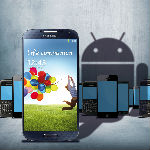
Android tops a market set to reach 1.4bn devices this year
Today, smartphones have become computers in their own right, with an ABI study predicting that 1.4 billion smartphones will be in use by the end of 2013. The war for smartphone supremacy wages on, with main contenders settling into the top five positions and emerging manufacturers trying to find their footing in this diverse and highly competitive market.
The first quarter of 2013 also marked the first time in the industry’s history that smartphones shipped more devices than feature phones. According to the IDC’s worldwide quarterly mobile phone tracker, smartphones accounted for 216.2 million of the 418.6 million units shipped, making up more than half of all mobile device shipments (51.6%).
Senior IDC research analyst Kevin Restivo says consumers have upped their phone needs and it’s showing in the figures. “The days where phones are used primarily to make phone calls and send text messages are quickly fading away. As a result, the balance of smartphone power has shifted to phone makers that are most dependent on smartphones.”
TITLE FIGHT
Competition for market leadership – among Apple, Samsung and BlackBerry – has increased exponentially, with each manufacturer trying to push innovation boundaries with the release of every new device. Local and international pundits agree that the title fight is more heated than ever.Mike Sharman, owner of digital communications agency Retroviral, says Samsung has, however, emerged as the top contender, because of the success it achieved with its S3 device globally and the hype it has managed to create for its S4.
 <a href=
<a href=
He adds that in South Africa, BlackBerry still commands a majority share in the mobile market. “Vodacom figures in November indicated 2.7 million BlackBerry smartphones on its network alone, while Android and iPhone comprised only 700 000 and 500 000, respectively. It will be interesting to see the latest stats, as I assume the Android figures will have climbed significantly.”
Meanwhile, Apple shares have recently come under pressure, as the market has started to see the company as ordinary and lacking innovation. Its second quarter results were released last month and its share price lost 0.54%, to $403.95. Apple sold 37.4 million iPhones in the quarter, compared to 35.1 million in the year-ago quarter.
Apple has also promised more innovation. CEO Tim Cook said in a statement: “Our teams are hard at work on some amazing new hardware, software and services, and we are very excited about the products in our pipeline.”
Africa Analysis telecoms analyst Dobek Pater says the real differentiating factor between the top two contenders, Apple and Samsung, comes down to taste. “iPhone is a status product, but is also very functional, user friendly, and aesthetically pleasing to the eye. It is a bit of a fad.”
 <a href=
<a href=
Pater adds that BlackBerry has lagged behind the top brands (Apple and Samsung) in producing a smartphone product with functionality matching that of the other two, and this has contributed to its decline.
Senior analyst at ABI Aapo Markkanen, however, believes that 2013 would yield relative success for other contenders, like Microsoft and BlackBerry. “For the end of the year, we expect there to be 45 million Windows Phone handsets in use, with BlackBerry 10 holding an installed base of close to 20 million.”
The figures refer to actively used devices, which is what app developers – with certain caveats in mind – should generally treat as an addressable market for their releases. Markkanen says the greatest fear for both Microsoft and BlackBerry is that the initial sales of their smartphones will disappoint and thereby kill off the developer interest, which then would effectively close the window of opportunity on further sales success.
“Our view is that the installed bases of this scale would be large enough to keep these two in the game. It will definitely also help that both firms have actively kept the developers’ interest in mind while designing and rolling out their platforms.”
SMART OPERATING
ABI predicts that by the end of 2013, 57% of smartphones will run on Android and 21% on iOS.Adding to this, the latest sales data from Kantar Worldpanel ComTech reveals Android has already jumped to the number one spot in leading markets, with 58.4% of the share in the UK and 49.3% in the US. According to Kantar, these figures are set to grow with new smartphone releases.
 Mike Sharman, Retroviral
Mike Sharman, Retroviral
“We expect to see a further spike in its share in the coming months, as sales from the HTC One start coming through and the Samsung Galaxy S4 is launched. This will pile pressure on Apple, BlackBerry and Nokia to keep their products front of consumers’ minds in the midst of a Samsung and HTC marketing blitz,” he adds.
Sunnebo says it is clear that one of the key drivers of Samsung’s performance is how targeted each device is. “Kantar Worldpanel ComTech data clearly shows that different Samsung models are appealing to a very different type of consumer. The Galaxy Note 2 is popular with affluent 25- to 34-year-old males, the Galaxy S3 Mini appeals to younger females, the Galaxy Ace to older females, while the Galaxy S3 has broad appeal.”
Sharman agrees and says he also expects Android numbers to continue to rise exponentially. “Especially on the Samsung front, due to innovative offerings such as the recently launched 1GB AlwaysOn WiFi allowance for new and existing customers.”
NETWORK SUPPORT
Pater says the ongoing war for supremacy is good news for the network operating companies, as it will provide them with more choice and a wider price range to compete on. “Operators are pursuing a strategy of pushing smartphones into the market in order to drive data usage. MTN has, for example, outlined a timeline for migrating all 2G devices on its network to 3G devices. They continually search for lower cost smartphones to reach the lower income groups within their subscriber bases.”Sharman adds that South Africa is fortunate enough to have some of the most advanced networks in the world and they are constantly upgrading their facilities. “LTE is being rolled out across all networks and speeds will continue to increase to enhance our data experiences. Unfortunately, with the mainstream adoption of smartphones, the networks will experience higher data volumes and be under pressure to deliver a high level of customer service. Different revenue models will need to be considered, with the demise of aspects such as SMS and the adoption of data driven instant messaging services.”
Voice quality might not be much of a problem at present, says Pater, as most users probably think that poorer quality of voice is the result of a substandard network rather than the device. “Presumably, the quality of voice on smartphones will improve over the next few years. But with smartphones, more and more users will load VOIP apps on their phones and bypass the circuit switched network – paying less for calls as data than as a voice service.
Pater adds that this is, however, not a threat in South Africa at present, but adds that over the next two years this will become more and more of a concern to network operators especially as the over the top players become more prominent in South Africa.
“Eventually, operating companies will migrate to VOIP as a voice service (once the LTE networks can support this), but they are trying to postpone this moment as long as possible, while they search for new business models to replace loss in revenue from voice services,” he notes.
GAME CHANGER
The recent release of Samsung’s Galaxy S4 has turned the smartphone war on its head, by introducing not only an array of innovative features but also giving consumers peace of mind offering the world’s first 24-month Accidental Damage from Handling (ADH) warranty to cover screen and liquid damages to the Galaxy S4 at no extra charge.This allows consumers to take the device to an authorised Samsung Service centre, which will replace the screen or board free of charge with no incident fee having to be paid by the customer.
Director of mobile communications for Samsung SA Craige Fleischer says it is essential for manufacturers to keep on innovating. “We keep looking to push that envelope and we have been successful thus far because each handset allows us to better understand the market in which we operate and what our customers want.”
Fleischer says manufacturers have to dig deeper than ever before as consumers want features that will add real value to their daily lives and with the S4 he believes Samsung has achieved that. “In line with this, we at Samsung are always looking to develop localised, relevant applications and ecosystems.”
He adds that Samsung is also edging towards the wearable device sphere with features like “S Health”, which uses a combination of sensors built into the handset to monitor the health of the user. It allows users to check their health conditions using food diary, exercise diary and sleep monitor to stay fit and healthy with certain functions enabled by specific accessories.
FUTURE EXPECTATIONS
World Wide Worx MD Arthur Goldstuck says consumers can expect the smartphone evolution to produce handsets that are slimmer and lighter, with even bigger screens. This will in return affect the market share, with some manufacturers not keeping up. “Unfortunately, this is where the iPhone might fall behind, as Apple does not want to move to bigger screens.”He adds that demands for the entry-level smartphone will also increase, but there is already a leader in this category. “Samsung has taken the lead with this with the Galaxy Pocket, offering an entry-level and affordable Android experience.”
Predictions from analyst firm Gartner backs this up, saying that users can expect to see the first $50 smartphone appear in emerging countries. In the report, Gartner says with the arrival of the $50 smartphone, the world is poised to use smartphones for far more than just phone calls. It adds that the phone will be an essential element to banking and other core services that will modernise many economies.
Pater says in time, the top brands will need to produce lower-cost versions of their devices or different models to counter that challenge. “But at present they are probably too busy to continue innovating at the top end, in order not to lose market share there.”
There is also the challenge for other lesser known manufacturers to enter the smartphone market and Pater says this won’t be an easy feat. “The challenge lies in introducing something that is better than what is already available in the market. The greatest challenge to the top smartphone brands will probably emerge from lesser known brands, like those from China, which will target the low-cost smartphone market.”
Sharman adds to this saying that while there still is a lot of room for quality contenders to enter and take on the frontrunners, it won’t be easy as barriers to entry for new players are high because of the marketing spend required to infiltrate the smartphone market.
Sharman also believes the future of smartphones will be centred on how they connect with each other. “We will see greater interconnectivity between the devices that we have become reliant on. Google Glass is a perfect example of where technological advancements can take us. We are not limited to a rectangular handset for our future smartphone needs.”
|
Post a comment
|
Login.
All rights reserved © Copyright by ITWeb, 2011


